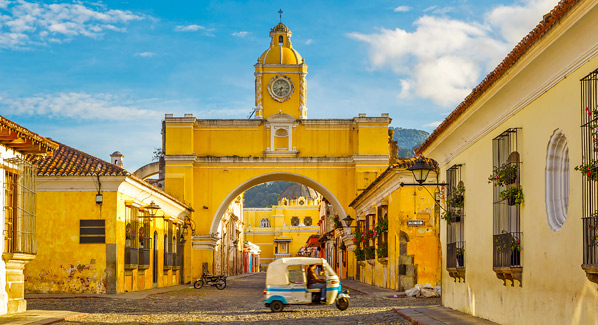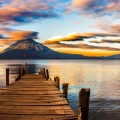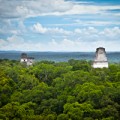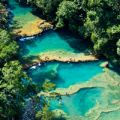From ancient stone temples cloaked in rainforest greens to colorful village markets and colonial-era cities perched in the shadow of a towering volcano, Guatemala delivers a full range of scenic and cultural treasures. Here, echoes of the Mayan Empire blend with memories of Spanish governance, and nature takes center stage in forest reserves and mountain highlands.
1 Volcanic Heights
The highlands of Guatemala are formed by 33 volcanic peaks, including 13,800-foot Tajumulco, which is the highest summit in Central America. A trio of active volcanoes adds drama to the mix, while dormant and extinct peaks such as San Pedro are favorites with hikers. One of the most scenic profiles is Atitlán, which rises to a height of two miles above the lake of the same name.
2 Colonial Memories
Once the capital of the former Kingdom of Guatemala, this 16th century city has survived devastating earthquakes and today is a UNESCO World Heritage Site. The cobblestone streets of the old town are lined with Colonial-era churches and Spanish Baroque- influenced architecture. Some landmark structures have been meticulously renovated, while others still show the ravages of past disasters. The city of Antigua is framed by three of the most photographed volcanoes in Guatemala: Volcán de Agua, the water volcano, Volcán de Fuego, the fire volcano and the Volcán Acatenango, which is known as the third sister.
3 The Deep Lake
Once called the most beautiful lake in the world by European explorers, Lake Atitlán remains Guatemala’s number one tourist attraction. Ringed by volcanic peaks, the clear waters of the lake plunge to depths of more than 1,000 feet. Traditional villages clustered around the shoreline are home to people of Tz’utujil and Kaqchikel Mayan heritage, and it is common to see traditional styles of dress and hear local dialects spoken in markets and town squares.
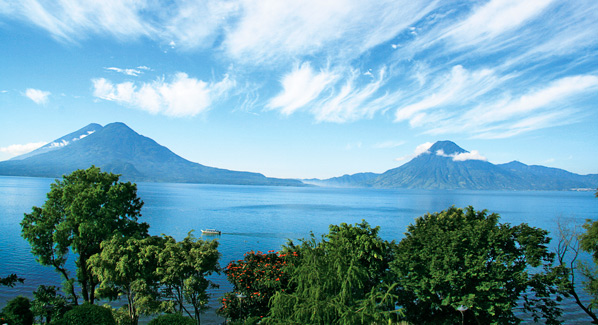
Lake Atitlán was formed by volcanic activity more than eighty thousand years ago. It is the deepest lake in Central American, and a favorite attraction. Photo: iStock
4 Wonderful Waterfalls
Falling water takes many forms in Guatemala, from bubbling hot springs to thundering cascades. One of the tallest waterfalls in Central America, El Salto de Chilascó, is reached by a hike through cloud forests in the Sierra de las Minas Biosphere Reserve. The Cahabón River flows through a series of limestone bridges and cascading pools known as the Semuc Champey. The spillways of the Siete Altares, or Seven Altars, fill fresh water pools hidden within a coastal rainforest.
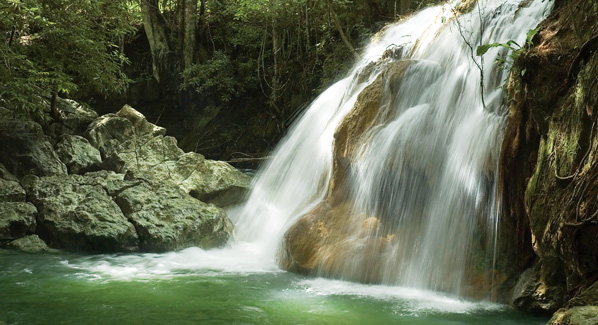
At the Finca el Paraiso, waters from an artesian hot spring mingle with a jungle stream to cascade into a refreshing bathing pool. Photo: iStock
5 A Wild Kingdom
The country once known as Goathemala, the land of the trees contains large tracts of natural habitat, including the region’s largest cloud forest and the approximately 3.5-million acre Maya Biosphere Reserve. Guatemala ranks among the 25 most bio- diverse countries in the world, with 18 ecosystems and more than 300 microclimates. Its jungles are home to big cats such as jaguar, cougar and ocelot. The trees hold spider monkey and the signature primate, the howler monkey is often seen in the jungles around Mayan temples.
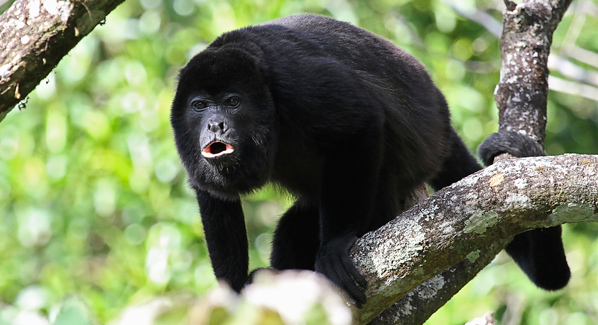
The distinctive calls of howler monkeys are heard through the jungles of Guatemala. These primates may be seen around ruins. Photo: Sekar Baiasubsamariani/Stock
6 Market Values
One of the world’s most colorful shopping experiences takes place in Chichicastanengo. Each Sunday and Thursday, cobblestone streets are lined with stalls as local artisans from across the region converge on this historic and scenic village to stage the largest open-air market in Central America. Tourists join locals to barter for hand-made goods like blankets, textiles and weavings, pottery, jewelry and woodcarvings. Conversations and deal making takes place in Spanish, broken English and the numerous local dialects of the region.
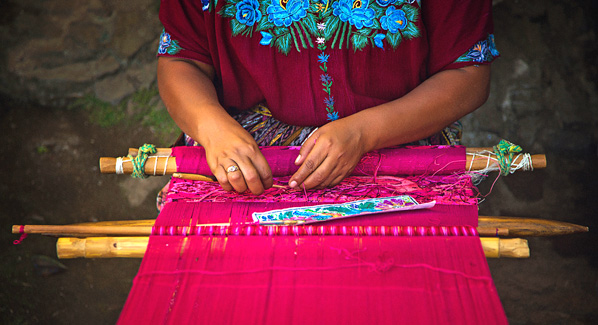
Throughout Guatemala traditional skills such as hand weaving are still practiced by indigenous people of Mayan descent. Photo: iStock
7 Two By Sea
The country’s two coastlines offer distinctly different settings. On the west, the cooler waters of the Pacific lure surfers with swells that break on black sand beaches. To the east, Guatemala stakes a toehold on the Gulf of Honduras where the Rio Dulce flows into the Caribbean. This coast is home to Garifuna culture, and includes the expansive wetlands reserves of Bocas del Polochic and Punta de Manabique, along with a sampling of palm-lined beaches.
8 Ancient Cities
Present day Guatemala was once the heart of Mayan civilization, and the long forgotten remains of grand stone cities now draw visitors from around the world. At the top of the list are the sprawling grounds and iconic pyramids of Tikal. To the west lies Zaculeu, which is known as the White City for its light colored stonework. Quiriguá is noted for the tallest stone sculpture erected in the New World and the temples of Yaxha are still being carved from the jungle. Just across the border in Honduras is Copan, which is famous for its hieroglyphic stairway and extensive carvings.
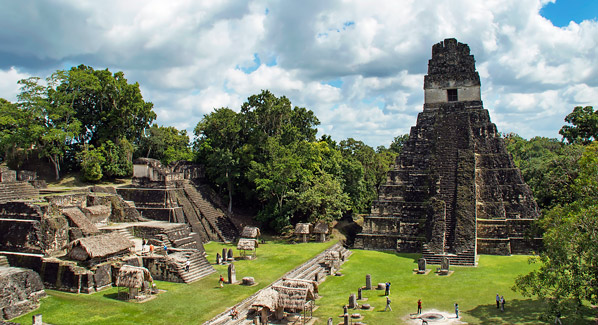
The distinctive pyramids of Tikal draw visitors from around the world. This ancient city was once a major capital of the Mayan Empire. Photo: iStock
9 The Old Ways
Even after centuries of Spanish influence, traditions and languages handed down from the days of the Mayan Empire are still found in many regions of Guatemala. Indigenous populations of Mayan heritage make up more than half the country’s population, and groups including Q’eqchi, Cakchiquel, Mam, Tzutujil, Achi and Pokoman maintain traditional cultural identities and customs. More than 20 pre-Colombian languages and dozens more regional dialects are spoken across the country, though Spanish is used for universal communication.
10 Premium Brews
Some of the world’s finest coffees are grown on the volcanic slopes of Guatemala’s western highlands, where the traditional method known as shade growing is practiced. Many coffee plantations offer walking tours that showcase the growing, harvesting, and roasting process. Some farms are also established as private nature reserves, offering overnight stays and other activities such as bird watching, hiking and horseback rides.

